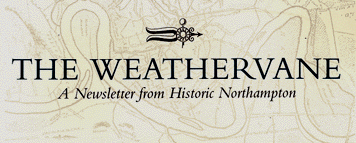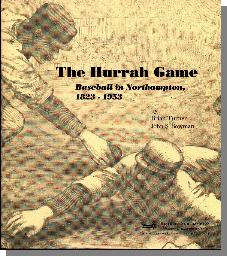

|


Weathervane Newsletter Summer 2002

The Hurrah Game captures glory that was Hamp Baseball PART I
Were members of the 19th century Florence Eagles baseball team sore losers? In the pages of "The Hurrah Game: Baseball in Northampton, 1823-1953," authors Brian Turner and John S. Bowman note that after being beaten, the team complained.
The ball used by the Hampdens was too light, the team alleged after a game in October 1866. The umpire hired by another home team was biased. Sore losers, or just really serious about this game? Maybe about contests of any kind, for some players were just back from the Civil War. This was the team, after all, that so wanted to protect a perfect record earlier that players disguised themselves in the uniforms of the Bay State Fire Company team and tested-a would-be rival from Chicopee.
"Sport" can be an elusive quality in games. What's always there is human nature, and Bowman shellac into this small volume. Though prepared as an catalog for an exhibit at Historic Northampton, the book stands alone as a quick and richly illustrated history of the nation's game, writ local. Turner teaches writing at Smith College. Bowman is an independent book author and editor.
The authors take their title from a letter poet Walt Whitman wrote in 1888, in which he refers to baseball as "the hurrah game" and calls it "just as important in the sum total of our historic life" as the Constitution .
The sum of what Turner and Bowman assemble says a lot about how people once lived in Northampton, though that's not their purpose. As diehard fans of the game, they revel in the fragments of stories about games, teams and players that they uncovered in the pages of old newspapers and, in some instances, from interviews. Reading "The Hurrah Game," you can keep your eye on the ball -- the box scores and rosters -- or watch, like a fielder, for the whole picture. That's because in their quest to assemble a picture of baseball in Northampton over 170 years, Turner and Bowman sweep in details of a broader picture of 19th and early 20th century life.
For one, there are those long-lost trolley cars, moving through Northampton like the arcs of remembered home runs. There's the abolitionist singing troupe that liked to unwind with a bit of baseball. The authors show us the massive elm that once stood near the Connecticut River at Hockanum Ferry, beside a ballfield.
As Turner makes clear in a preface, it is detail like that, even hanging free of theme or context, that quickens our feel for history. Turner's graceful opening essay recalls many moments of his friendship with Jim Ryan, who died in 2000. Ryan, who played with the Florence Braves 80 years ago, kept telling Turner things that sent the younger man to the microfilm at Forbes Library.
Turner found a Gazette story about a game played at the Driving Park, located on the fairgrounds, where audiences arrived both in cars and horse-drawn buggies. "Such a foul fly is seldom seen in these parts," the newspaper said of one play. "[The fielder] jumped the rope fence and making his way around autos and teams picked the ball off a horse's back." It's not clear whether that was ruled a catch.
Out of Turner's trips to the library, his talks with Ryan and his collaboration with Bowman, this book and exhibit emerged. Baseball could be as rough, rascally and impoverished as its times, they found. In one talk with Turner, Ryan described a field his Florence Braves team once used at the Smith Vocational and Agricultural High School this way: "The field at Smith's School was sandy. Left field went downhill, so the fielder disappeared when he chased a long fly ball. Some fielders took a ball along with them.
Their baseball was played through an era when fans were far more loyal to regional teams than to the national leagues. The sport was glorious and corrupt, full of great highs of victory and the troughs of scandal, bad behavior and outright collapse, for the sport's prospects tended to rise and fall with the business cycle.
Contents Copyright 2025. Historic Northampton.